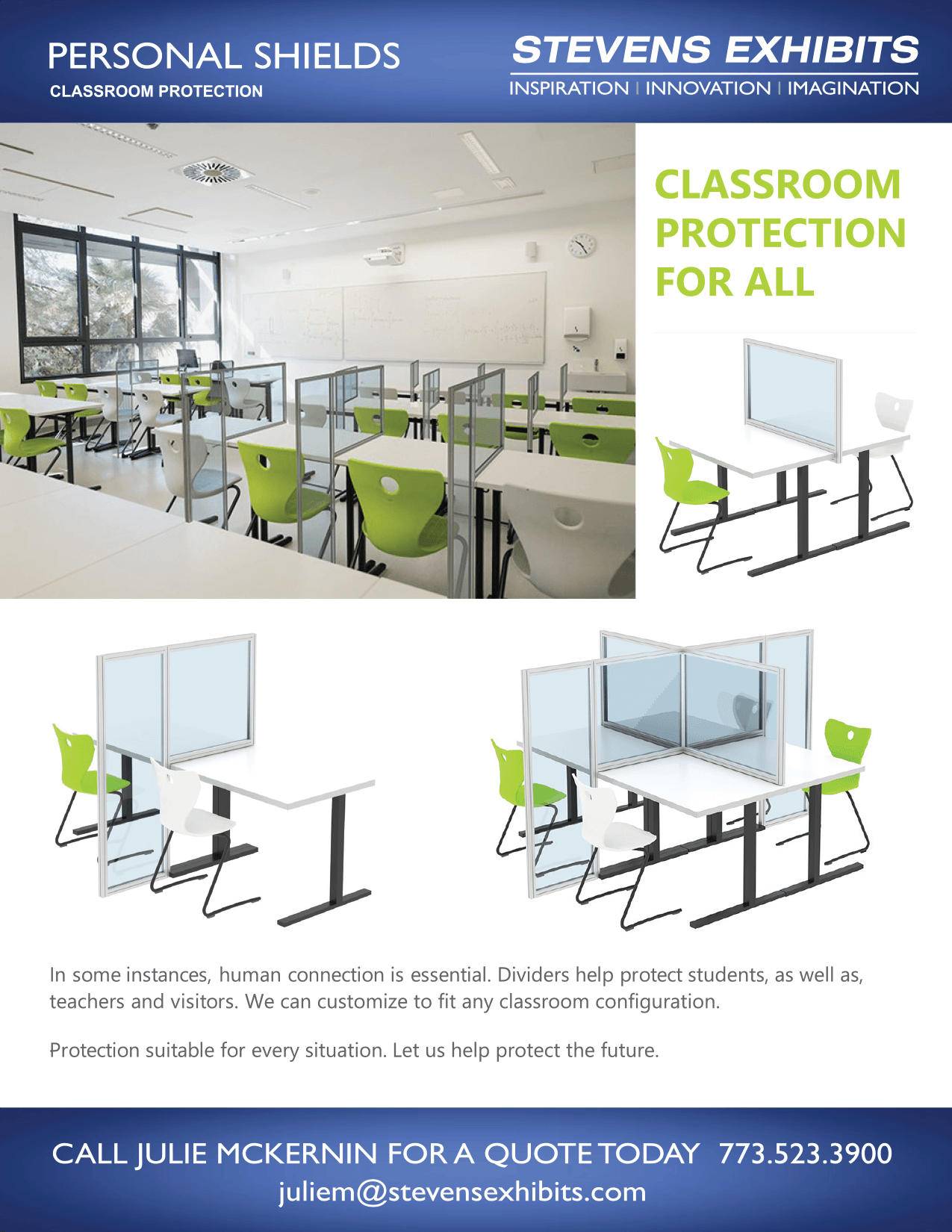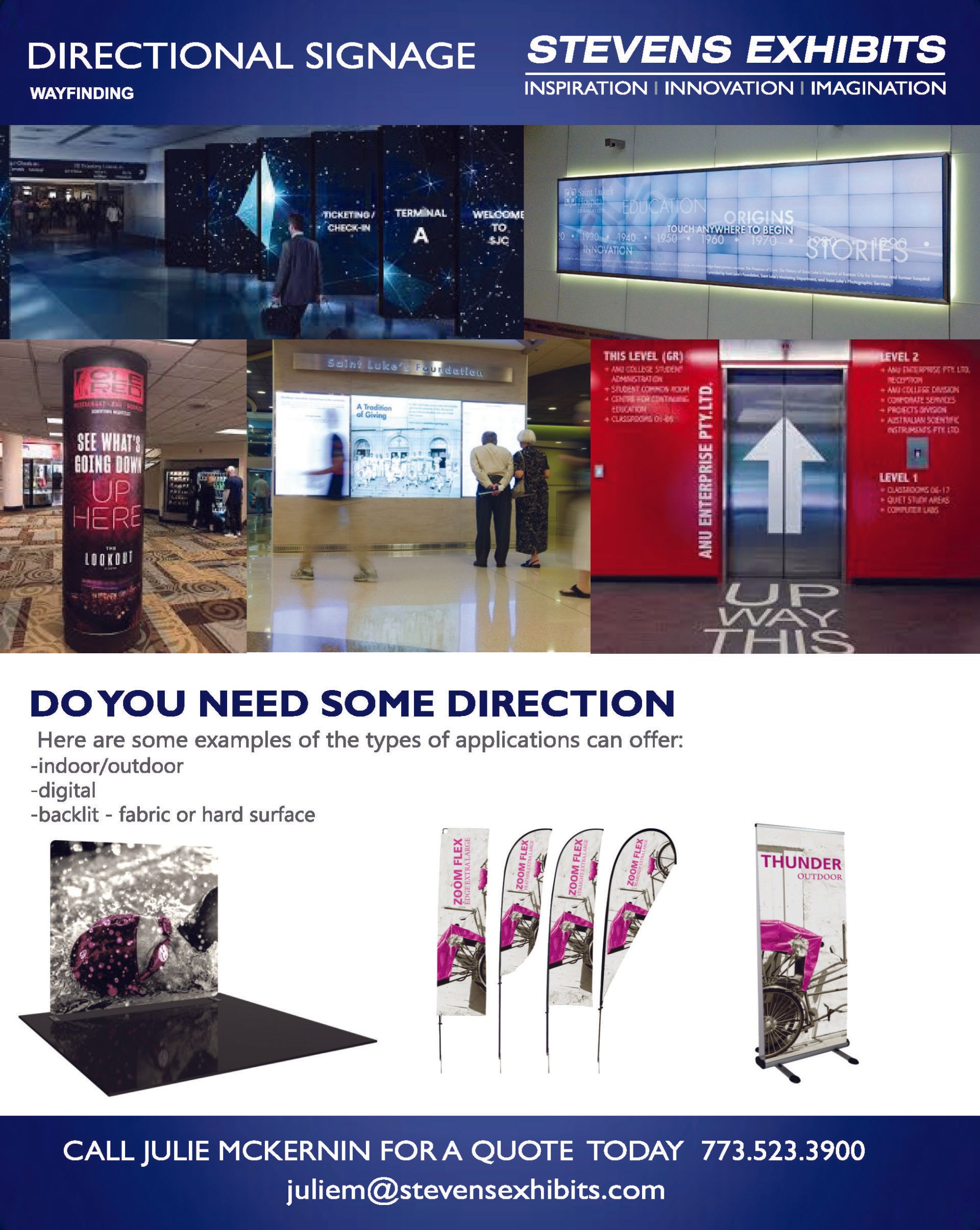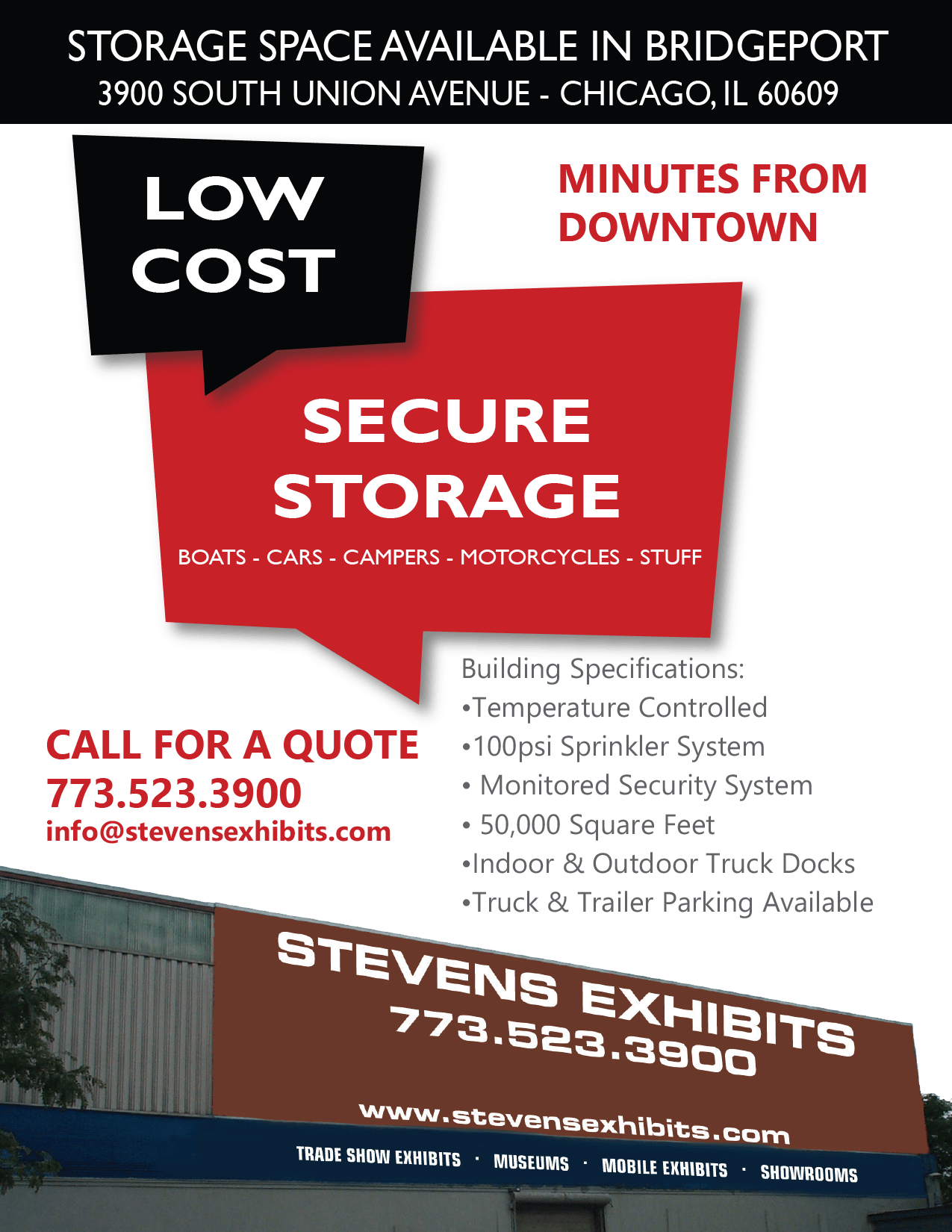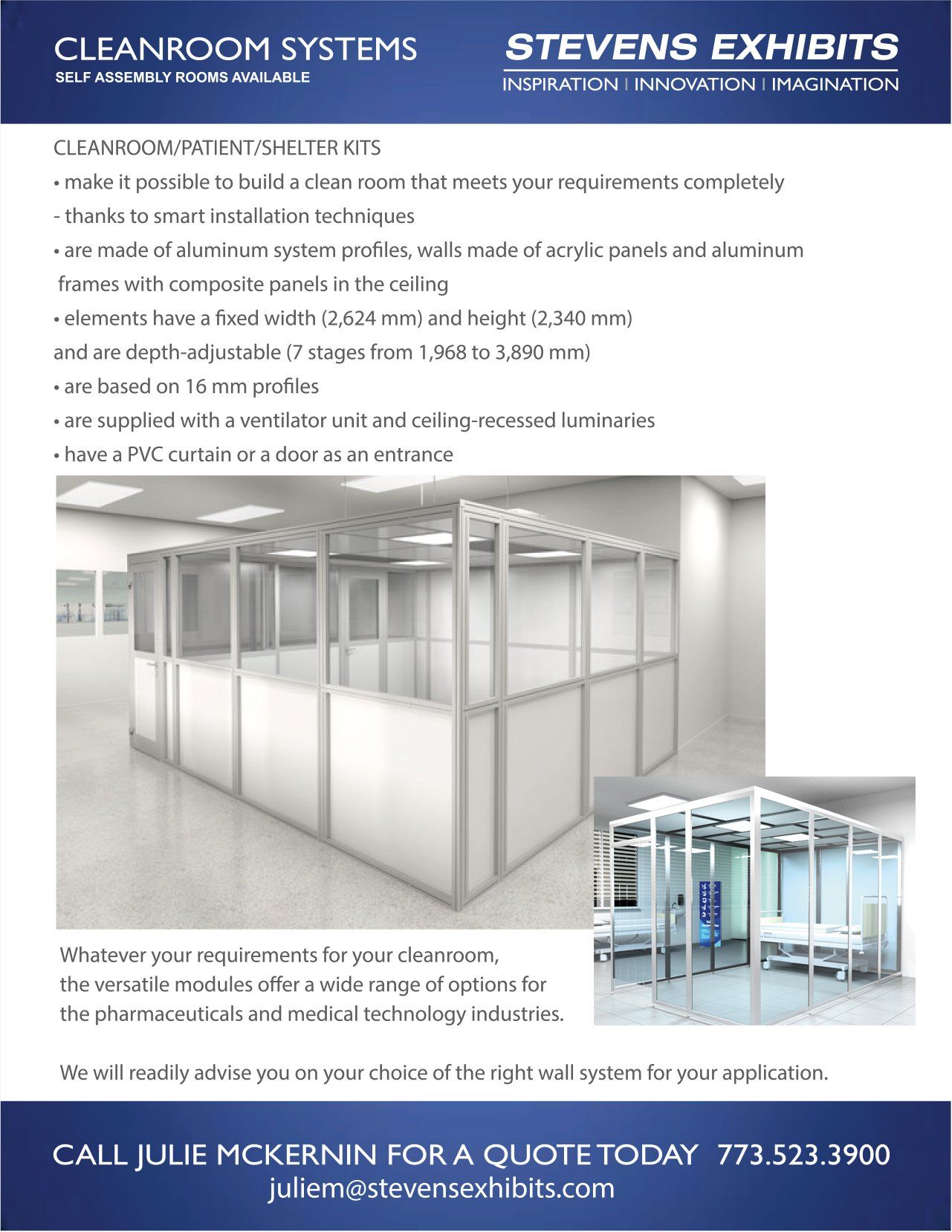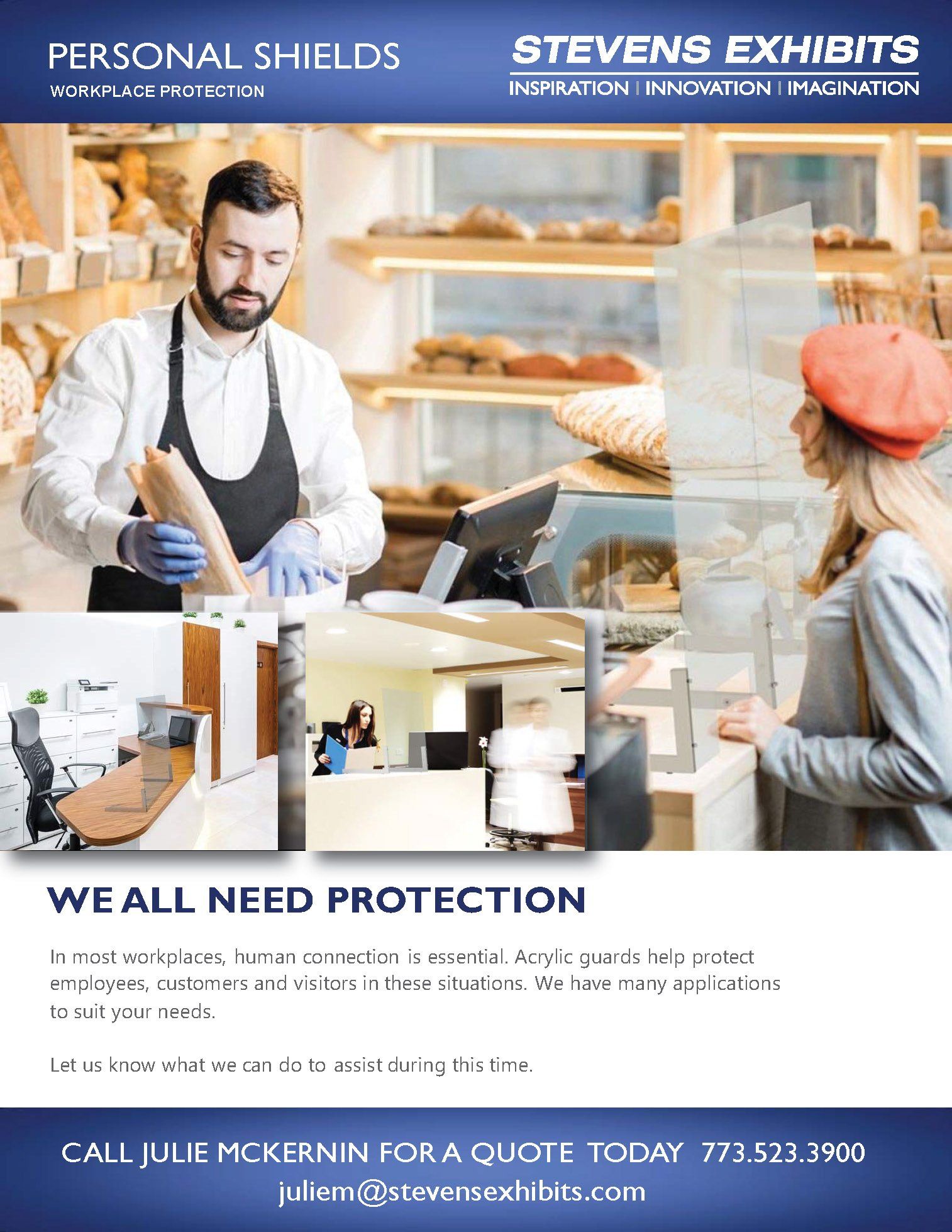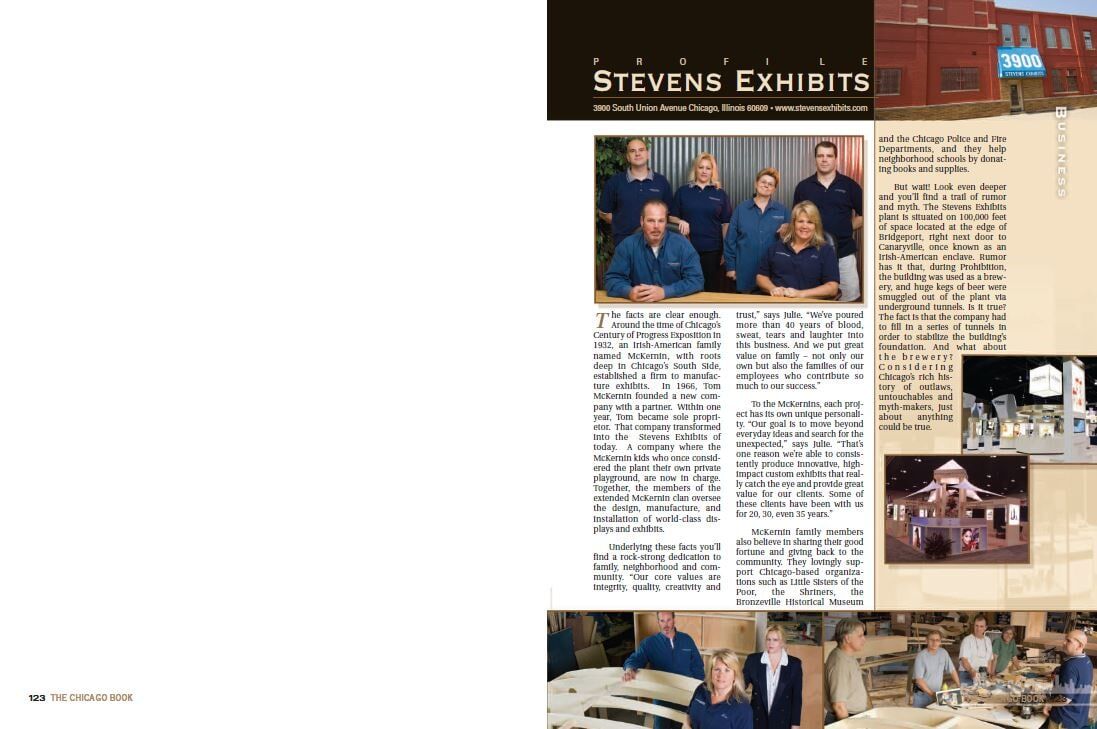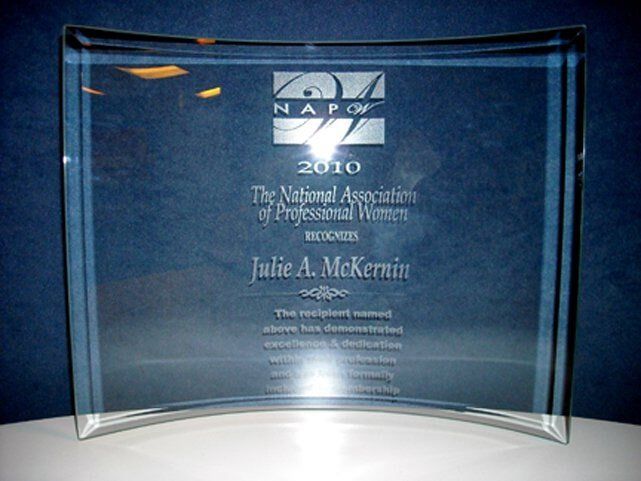News & Media
NEWS & MEDIA AT STEVENS EXHIBITS
New Offerings in 2020 (COVID-19)
Best Practices: Finding the Right Builder
Written by: Natalie Relf
Friday, December 28, 2012
A dynamic exhibit space is the tradeshow's holy grail. It's essential to find the ideal exhibit builder since design concepts vary greatly in size and intricacy. The right fit is obtained through a variety of factors such as research, consultation, affordability and advocacy.
Friday, December 28, 2012
A dynamic exhibit space is the tradeshow's holy grail. It's essential to find the ideal exhibit builder since design concepts vary greatly in size and intricacy. The right fit is obtained through a variety of factors such as research, consultation, affordability and advocacy.
DECIDING ON A BUILDER
In-depth examination is key to acquiring a contractor capable of bringing a brand to life. Some crucial features when choosing the right company include its history, past and present clients, the types of services offered and past execution

Stevens Exhibits begins the client-builder relationship by listening to what the customer wants, not just trying to interpret their needs.
“There are a number of factors that influence the selection of an exhibit contractor,” said Julie Mckernin, vice president of marketing and sales, Stevens Exhibits/Displays Inc. “One of the most influential would be the company's history of building a wide range of designs and styles.”
The size of the company shouldn't necessarily be a predominate factor either.
“Often, when choosing an exhibit builder, an exhibitor thinks bigger is better,” said Don Szabo, vice president of program strategies, Gallo Exhibits. “Yes, the larger exhibit houses have a diversity of resources, and resources are important, but it is the capability to correctly leverage all of these resources for a client that is so important, and then to skillfully execute within the deadlines. This comes with experience, which is a crucial factor.”
Communication is the main building block that lays the foundation of a successful project. Discussion time can bring customer ideas and needs to the table for a clearer understanding of the project vision. According to McKernin, if company representatives leave a meeting with potentially new or existing clients, and have to return to the office and decipher, they've missed the whole meeting. The builder should begin by listening to what the customer wants, they shouldn't just interpret the client's needs.
“Regardless of the size of the exhibit, an exhibitor should look to partner with a company that provides a consultative approach,” said Szabo. “A smart-thinking exhibit house, uses the consultative process to strategically discover a client's needs and overall brand direction, and how best to meet those needs to deepen brand equity.”
The bidding process is another area that can hamper a successful build.
“It is important when selecting an exhibit partner, especially when bidding out the tradeshow production, that the exhibitor is able to compare apples with apples,” said Tom Lemery, president and CEO of Creactor Inc. “The best way to do this is give each bidder the exact specifications to bid on, including all show related services, as well as an exhibit design.”
Budget limitations can also make or break planning strategies. Most providers can service any exhibitor's funding, but if the customer doesn't have the basic budget planning handled, things can go south quickly. Lemery suggests asking bidders to provide a quote on production. This allows for side-by-side quote comparison, but also to compare quotes with the actual cost of the exhibit. He also recommends asking for an itemized quote to conduct a line-by-line evaluation.
The size of the company shouldn't necessarily be a predominate factor either.
“Often, when choosing an exhibit builder, an exhibitor thinks bigger is better,” said Don Szabo, vice president of program strategies, Gallo Exhibits. “Yes, the larger exhibit houses have a diversity of resources, and resources are important, but it is the capability to correctly leverage all of these resources for a client that is so important, and then to skillfully execute within the deadlines. This comes with experience, which is a crucial factor.”
Communication is the main building block that lays the foundation of a successful project. Discussion time can bring customer ideas and needs to the table for a clearer understanding of the project vision. According to McKernin, if company representatives leave a meeting with potentially new or existing clients, and have to return to the office and decipher, they've missed the whole meeting. The builder should begin by listening to what the customer wants, they shouldn't just interpret the client's needs.
“Regardless of the size of the exhibit, an exhibitor should look to partner with a company that provides a consultative approach,” said Szabo. “A smart-thinking exhibit house, uses the consultative process to strategically discover a client's needs and overall brand direction, and how best to meet those needs to deepen brand equity.”
The bidding process is another area that can hamper a successful build.
“It is important when selecting an exhibit partner, especially when bidding out the tradeshow production, that the exhibitor is able to compare apples with apples,” said Tom Lemery, president and CEO of Creactor Inc. “The best way to do this is give each bidder the exact specifications to bid on, including all show related services, as well as an exhibit design.”
Budget limitations can also make or break planning strategies. Most providers can service any exhibitor's funding, but if the customer doesn't have the basic budget planning handled, things can go south quickly. Lemery suggests asking bidders to provide a quote on production. This allows for side-by-side quote comparison, but also to compare quotes with the actual cost of the exhibit. He also recommends asking for an itemized quote to conduct a line-by-line evaluation.
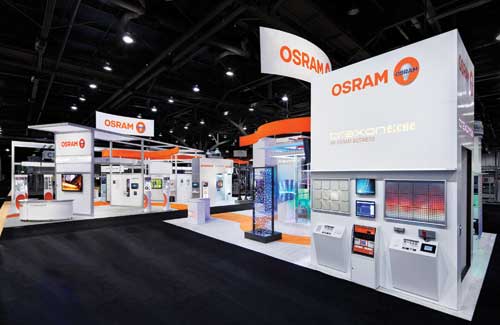
Creatacor is offering show scheduling, budgeting, asset management and logistics to help exhibitors manage their tradeshow program.
“While rates can be important, they are not an accurate measurement of the actual cost to the client,” said Lemery. “By requesting suppliers to bid on an actual project, the client will have a more accurate picture of the cost. This can be done even if the client isn't looking for a new exhibit, but wants a new supplier to offer costs for maintaining the program.”
Deciding on the best builder to do the job can be difficult when free enterprise has made competition so fierce. Only by doing the homework is the client prepared enough to settle on the right fit. Strong affiliations make the production process significantly easier as well.
“Price alone should not be the determining factor when selecting your exhibit provider,” said Lemery. “It is extremely important that the exhibiting company be comfortable with the provider and that there is a sense of partnership. Many times exhibitors select the provider based solely on price only to find out that they do not receive the added value that comes with a solid relationship.”
Szabo recommends asking a few questions to determine if the company is successfully meeting client needs such as: Are they becoming a strategic partner, one that is bringing valuable information and insight to the table? Am I comfortable with putting them in an internal strategy meeting, which may or may not be directly tied to a tradeshow requirement? If the answer is “no,” then the builder is not meeting your needs.
“The preferred exhibit provider shows a strong willingness to truly immerse themselves in the company so that they can better understand the needs and challenges'” said Szabo. “The company then puts together a concise process plan to meet those challenges.”
The time spent researching a contractor can save time later in the building process. Lemery maintains it is never too early to start conducting research, giving a window of 12-18 months pre-show for larger productions and 6-12 for smaller ones.
“While time is a commodity that seems harder to find, it is still one of the most important factors determining the success of the project and should be prioritized,” said Lemery.
By examining previous or current customer backing, the client can also gauge success rates and ability. Tradeshow real estate is not cheap. The best way to maximize it is by choosing a provider that understands its clients. The best way to tell is by petitioning those who have gone before.
“If existing clients can't tell or support a compelling story of past experiences, you may as well shut your doors and close up shop,” said McKernin. “Advocacy is the best supporter of credibility and integrity.”
“While rates can be important, they are not an accurate measurement of the actual cost to the client,” said Lemery. “By requesting suppliers to bid on an actual project, the client will have a more accurate picture of the cost. This can be done even if the client isn't looking for a new exhibit, but wants a new supplier to offer costs for maintaining the program.”
Deciding on the best builder to do the job can be difficult when free enterprise has made competition so fierce. Only by doing the homework is the client prepared enough to settle on the right fit. Strong affiliations make the production process significantly easier as well.
“Price alone should not be the determining factor when selecting your exhibit provider,” said Lemery. “It is extremely important that the exhibiting company be comfortable with the provider and that there is a sense of partnership. Many times exhibitors select the provider based solely on price only to find out that they do not receive the added value that comes with a solid relationship.”
Szabo recommends asking a few questions to determine if the company is successfully meeting client needs such as: Are they becoming a strategic partner, one that is bringing valuable information and insight to the table? Am I comfortable with putting them in an internal strategy meeting, which may or may not be directly tied to a tradeshow requirement? If the answer is “no,” then the builder is not meeting your needs.
“The preferred exhibit provider shows a strong willingness to truly immerse themselves in the company so that they can better understand the needs and challenges'” said Szabo. “The company then puts together a concise process plan to meet those challenges.”
The time spent researching a contractor can save time later in the building process. Lemery maintains it is never too early to start conducting research, giving a window of 12-18 months pre-show for larger productions and 6-12 for smaller ones.
“While time is a commodity that seems harder to find, it is still one of the most important factors determining the success of the project and should be prioritized,” said Lemery.
By examining previous or current customer backing, the client can also gauge success rates and ability. Tradeshow real estate is not cheap. The best way to maximize it is by choosing a provider that understands its clients. The best way to tell is by petitioning those who have gone before.
“If existing clients can't tell or support a compelling story of past experiences, you may as well shut your doors and close up shop,” said McKernin. “Advocacy is the best supporter of credibility and integrity.”
BUILDING THE BEST POSSIBLE EXHIBIT
Every company wants to put their best face forward at a tradeshow and achieve their ultimate branding goals. And in the end, the vision must be realized by the exhibit builder.
According to Lemery one way of achieving those ends is by asking:
According to Lemery one way of achieving those ends is by asking:
- Will the exhibit communicate the personality, culture and the best overall marketing message for my company?
- Will the exhibit physically meet the demands of the event (enough people space, product demo space, conference rooms, information fulfillment area, product demos, graphics, etc.)?
- Will my exhibit integrate with my advertising, website and other supporting activities, events or sponsorships associated with the show?
- Will my exhibit work for my other trade shows or event participation plans?
- Will the message ring clearly with my customers and prospects?
- Will my products and/or services be represented the best way possible with my marketing strategies and objectives in mind?
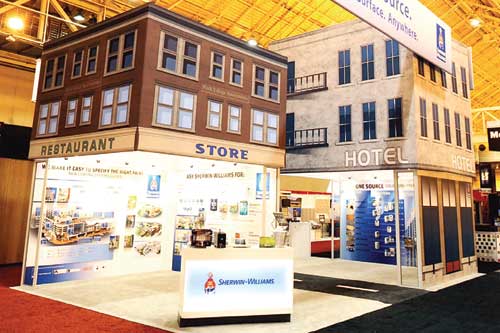
Gallo Exhibits is using hybrid solutions, allowing exhibitors to work their way into an exhibit by utilizing rental and purchase components.
Once all parties are cohesive about what the client wants, it can be realized effectively. According to McKernin, there are many factors, ranging from material selection to style, but the most important component in building the best exhibit is meeting client objectives and supporting their brand.
Szabo agrees.
“It begins by understanding the exhibitor's challenges,” he said. “Many times, exhibitors fall victim to preconceived designs, coming up with the design first and then adapting it to meet the challenges. Instead, it is important to extract information including challenges, and then allowing that information to drive the design process.”
Once all parties are cohesive about what the client wants, it can be realized effectively. According to McKernin, there are many factors, ranging from material selection to style, but the most important component in building the best exhibit is meeting client objectives and supporting their brand.
Szabo agrees.
“It begins by understanding the exhibitor's challenges,” he said. “Many times, exhibitors fall victim to preconceived designs, coming up with the design first and then adapting it to meet the challenges. Instead, it is important to extract information including challenges, and then allowing that information to drive the design process.”
USER-FRIENDLY SERVICE TRENDS
The tradeshow is a living, breathing entity that is always evolving. And new service trends are bringing diverse options to the provider's arena. Gallo Exhibits is using what they call hybrid solutions, allowing exhibitors to work their way into their dream exhibit by utilizing rental and purchase components to fit within their budget.
“A trend clients find advantageous is to work with a strategic partner that has multi-faceted offerings,” said Szabo. “A situation where it would normally require the client to coordinate with five or six vendors can be handled through one point of contact thus saving time and resulting in better execution of the total project. The offerings may include digital marketing, mobile programs, traveling exhibits, permanent installations and museum services.”
Creatacor is offering web-integrated programs, which include show scheduling, budgeting, asset management, graphic production, portable exhibit programs, job cost tracking and logistics to help exhibitors manage their entire tradeshow program.
“Excellence in customer service has been and always must be the number one priority for an exhibit provider and that starts with communications,” said Lemery. “Communicating and obtaining accurate information to and from your exhibit partner is essential for the exhibitor to make decisions and take actions that will optimize their tradeshow and event participation.”
“A trend clients find advantageous is to work with a strategic partner that has multi-faceted offerings,” said Szabo. “A situation where it would normally require the client to coordinate with five or six vendors can be handled through one point of contact thus saving time and resulting in better execution of the total project. The offerings may include digital marketing, mobile programs, traveling exhibits, permanent installations and museum services.”
Creatacor is offering web-integrated programs, which include show scheduling, budgeting, asset management, graphic production, portable exhibit programs, job cost tracking and logistics to help exhibitors manage their entire tradeshow program.
“Excellence in customer service has been and always must be the number one priority for an exhibit provider and that starts with communications,” said Lemery. “Communicating and obtaining accurate information to and from your exhibit partner is essential for the exhibitor to make decisions and take actions that will optimize their tradeshow and event participation.”
Show floor labor comes in all shapes and sizes
Written by: Natalie Relf
Monday, January 14, 2013
Not all contractors are created equal when it comes to installation and dismantle (I&D) services. And although all contractors are focused on providing a seamless experience for exhibitors, there are decided pros and cons depending on which type of service provider is used.
Monday, January 14, 2013
Not all contractors are created equal when it comes to installation and dismantle (I&D) services. And although all contractors are focused on providing a seamless experience for exhibitors, there are decided pros and cons depending on which type of service provider is used.
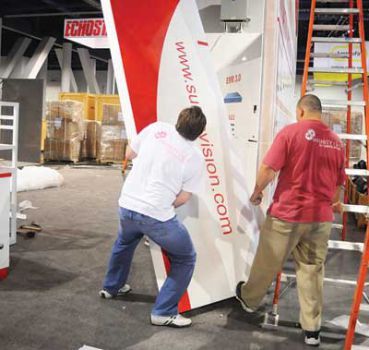
The choice of general contractor or exhibitor appointed contractor for show labor often depends on the needs of the exhibitor.
Exhibitor appointed contractors (EAC) specialize in exhibit-building services, and general contractors (GC) with I&D divisions have the resources to make all aspects of production convenient. The decision on which to choose to best suit the exhibitor's needs can be tricky without the facts.
“There are hundreds of EACs available with a vast array of levels of service, offerings and accountability,” said Linda Lizardi Rubin, CEM, director of exhibit solutions and services, Shepard Exposition Services. “Exhibitors need to understand their specific program to best determine who would be the best vendor fit, whether an EAC or the show official service contractor.”
With so many alternatives available, exhibitors need to take a comprehensive look at their options. According to Aaron Bludworth, president and CEO of Fern Exposition and Event Services, the selection process involves numerous factors, and when an EAC is also the show's official service contractor, there are some distinct logistical advantages.
“These differentiators, in many cases, include nationwide operations with local warehousing and full-time personnel, advanced access to show site, tighter coordination with the delivery of contractor provided services, and other natural efficiencies that come from having a single provider for numerous services,” said Bludworth.
Other considerations consist of the GC's ability to provide a wide variety of rental exhibit options, because of large inventories of equipment, and the creation of turnkey packages, which include all contractor-provided services.
Another distinct advantage to using a GC is their capability to facilitate a set-up before the client arrives. Larger shows with targeted move-in dates can delay an EAC, whether the exhibitor is there or not. The GC has the ability to complete a booth set according to their specifications and time constraints because they control all aspects of logistics.
“The booth can be handled as a priority and will be available and show-ready at the beginning of the exhibitor move-in,” said Rubin. “The official service contractor has been selected by the show organizer to provide services to their show. So the exhibitor can be confident they have a clear understanding of the event, the show rules, regulations, schedule and the unique aspects of the venue.”
“There are hundreds of EACs available with a vast array of levels of service, offerings and accountability,” said Linda Lizardi Rubin, CEM, director of exhibit solutions and services, Shepard Exposition Services. “Exhibitors need to understand their specific program to best determine who would be the best vendor fit, whether an EAC or the show official service contractor.”
With so many alternatives available, exhibitors need to take a comprehensive look at their options. According to Aaron Bludworth, president and CEO of Fern Exposition and Event Services, the selection process involves numerous factors, and when an EAC is also the show's official service contractor, there are some distinct logistical advantages.
“These differentiators, in many cases, include nationwide operations with local warehousing and full-time personnel, advanced access to show site, tighter coordination with the delivery of contractor provided services, and other natural efficiencies that come from having a single provider for numerous services,” said Bludworth.
Other considerations consist of the GC's ability to provide a wide variety of rental exhibit options, because of large inventories of equipment, and the creation of turnkey packages, which include all contractor-provided services.
Another distinct advantage to using a GC is their capability to facilitate a set-up before the client arrives. Larger shows with targeted move-in dates can delay an EAC, whether the exhibitor is there or not. The GC has the ability to complete a booth set according to their specifications and time constraints because they control all aspects of logistics.
“The booth can be handled as a priority and will be available and show-ready at the beginning of the exhibitor move-in,” said Rubin. “The official service contractor has been selected by the show organizer to provide services to their show. So the exhibitor can be confident they have a clear understanding of the event, the show rules, regulations, schedule and the unique aspects of the venue.”
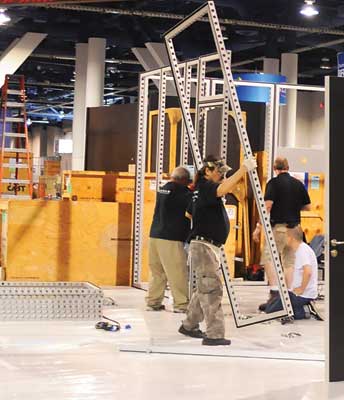
Contract terms, costs, discounts and service guarantees should all be considered when choosing a labor provider.
Still other benefits to using a GC, according to Rubin, are savings with transportation, no added charge for various rental components, no material-handling fees on rental properties, onsite move-in lounges, early return of empties, early access to the space and show-management approvals handled by staff. The financial aspects can be simplified as well with a single invoice and all insurance liabilities being covered.
“Using a (general) contractor as an EAC no longer means simply ordering labor from the service manual and dealing with what you get from a general pool of laborers,” said Bludworth. “Contractors have teams that are dedicated to exhibitor services, both for installation and dismantle work, as well as custom exhibit builds.”
The flip side of the coin allows for extremely personalized service since I&D is generally all an EAC is hired to complete. There is a significant reduction in the red tape often encountered when using a GC, and with an EAC, often times exhibitors will find they have better access to managers, account executives and even company owners.
“We make sure that every aspect of the show is working cohesively and smoothly,” said Julie Mckernin, vice president of sales and marketing, Stevens Exhibits and Displays. “Not just the booth structure itself, but we check on all components and services to make sure the client is completely ready to show; even if we did not place the orders. We confirm with the client that everything is satisfactory and they are show ready.”
The labor used by EACs also can be customized to suit the client. For example, Stevens Exhibits keeps its supervisors and labor staff on call 24 hours a day, seven days a week to accommodate the exhibitor. There are no lines to wait in for labor assistance and the same labor is assigned daily to avoid the confusion of random help.
“An I&D house offers very personal service,” said McKernin. “Our supervisor-carpenters make sure to actively participate and communicate with the client. When we dispatch, we're familiar with each carpenter; their years of experience, their specific skill set and their personality types. We can custom pick our carpenters to fit each job.”
Often times, things need to be constructed from scratch on the show floor. Having experienced, hand-picked labor can help guarantee things will be accomplished with efficiency and precision. Materials needed to complete a job are easily located as well since EACs bring everything to the show site.
“Using an EAC offers more accountability in all phases of the tradeshow and is by far the biggest advantage,” said Jean Keefe, relationship manager, Sholink. “We know the A to Z's of the client, what they have budgeted, and we create a booth around this budget to best capture their needs, audience and follow up.”
There are advantages to using either type of contractor, but which is right for the exhibitor is a decision they must make. Whether the topic of interest is service, speed or resources, all companies are looking to provide efficient, seamless experiences for its customers.
According to Rubin, for most exhibitors a clear understanding of exactly what their requirements, expectations and needs are will assist them in making the most effective decision when selecting any vendor or vendor partner. After potential vendors are narrowed down, then elements, such as contract terms, costs, discounts and service guarantees, should be factored in.
“Usually, it boils down to trust and confidence,” said Rubin. “Our industry is a people business, and most folks like to work with people they trust and are confident can provide the best service. With so many choices, if a client has done their homework, they'll choose who they trust and is committed to them.”
“Using a (general) contractor as an EAC no longer means simply ordering labor from the service manual and dealing with what you get from a general pool of laborers,” said Bludworth. “Contractors have teams that are dedicated to exhibitor services, both for installation and dismantle work, as well as custom exhibit builds.”
The flip side of the coin allows for extremely personalized service since I&D is generally all an EAC is hired to complete. There is a significant reduction in the red tape often encountered when using a GC, and with an EAC, often times exhibitors will find they have better access to managers, account executives and even company owners.
“We make sure that every aspect of the show is working cohesively and smoothly,” said Julie Mckernin, vice president of sales and marketing, Stevens Exhibits and Displays. “Not just the booth structure itself, but we check on all components and services to make sure the client is completely ready to show; even if we did not place the orders. We confirm with the client that everything is satisfactory and they are show ready.”
The labor used by EACs also can be customized to suit the client. For example, Stevens Exhibits keeps its supervisors and labor staff on call 24 hours a day, seven days a week to accommodate the exhibitor. There are no lines to wait in for labor assistance and the same labor is assigned daily to avoid the confusion of random help.
“An I&D house offers very personal service,” said McKernin. “Our supervisor-carpenters make sure to actively participate and communicate with the client. When we dispatch, we're familiar with each carpenter; their years of experience, their specific skill set and their personality types. We can custom pick our carpenters to fit each job.”
Often times, things need to be constructed from scratch on the show floor. Having experienced, hand-picked labor can help guarantee things will be accomplished with efficiency and precision. Materials needed to complete a job are easily located as well since EACs bring everything to the show site.
“Using an EAC offers more accountability in all phases of the tradeshow and is by far the biggest advantage,” said Jean Keefe, relationship manager, Sholink. “We know the A to Z's of the client, what they have budgeted, and we create a booth around this budget to best capture their needs, audience and follow up.”
There are advantages to using either type of contractor, but which is right for the exhibitor is a decision they must make. Whether the topic of interest is service, speed or resources, all companies are looking to provide efficient, seamless experiences for its customers.
According to Rubin, for most exhibitors a clear understanding of exactly what their requirements, expectations and needs are will assist them in making the most effective decision when selecting any vendor or vendor partner. After potential vendors are narrowed down, then elements, such as contract terms, costs, discounts and service guarantees, should be factored in.
“Usually, it boils down to trust and confidence,” said Rubin. “Our industry is a people business, and most folks like to work with people they trust and are confident can provide the best service. With so many choices, if a client has done their homework, they'll choose who they trust and is committed to them.”
HOURS OF OPERATION
| Mon-Fri | 8:00 AM - 5:00 PM |
| Sat-Sun | Closed |



BROWSE OUR WEBSITE
HOURS OF OPERATION
| Mon-Fri | 8:00 AM - 5:00 PM |
| Sat-Sun | Closed |



Images provided on this website are for personal, non-commercial use. Republication, retransmission, or reproduction of such images is strictly prohibited.
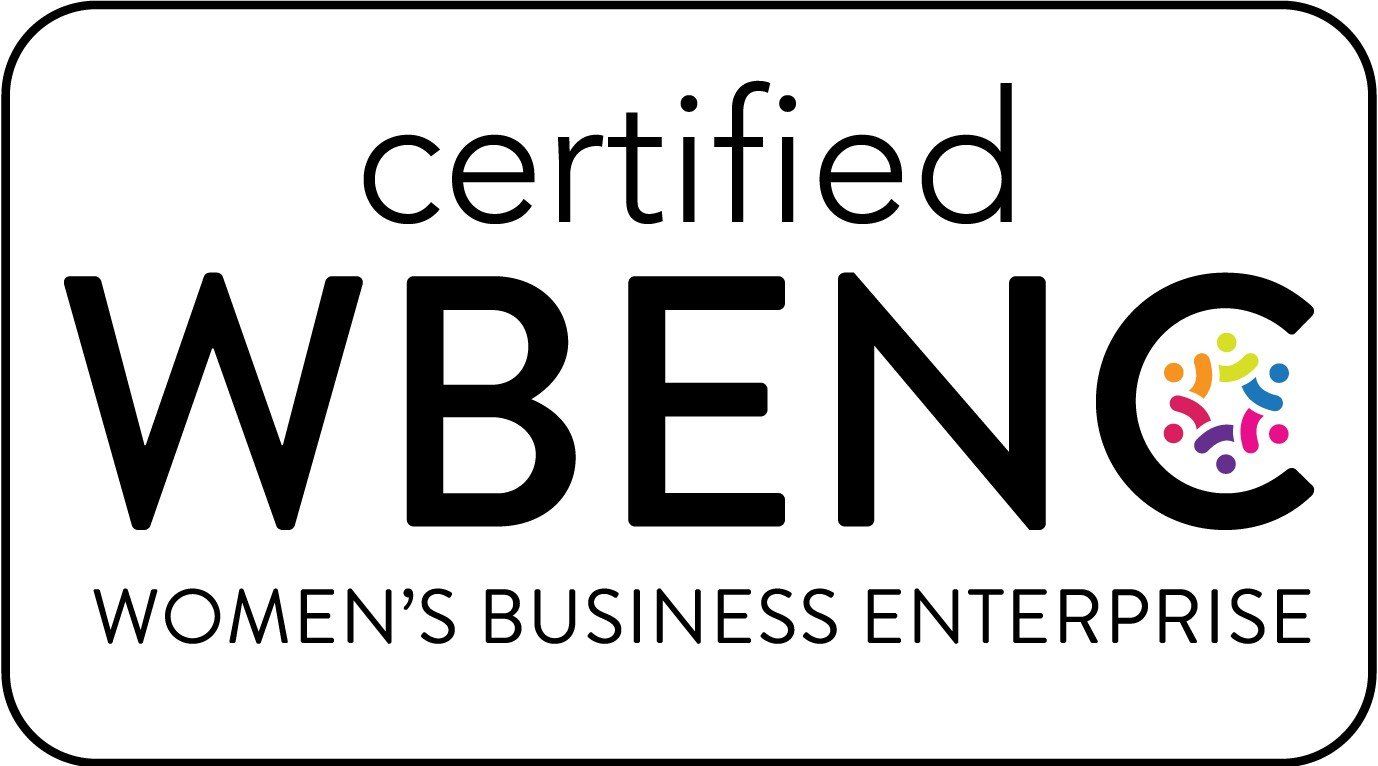


 3900 S Union Ave, Chicago, IL 60609
3900 S Union Ave, Chicago, IL 60609
